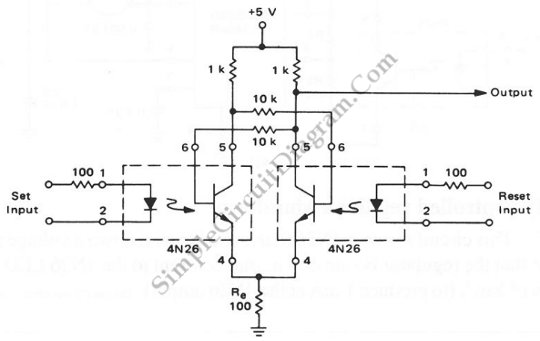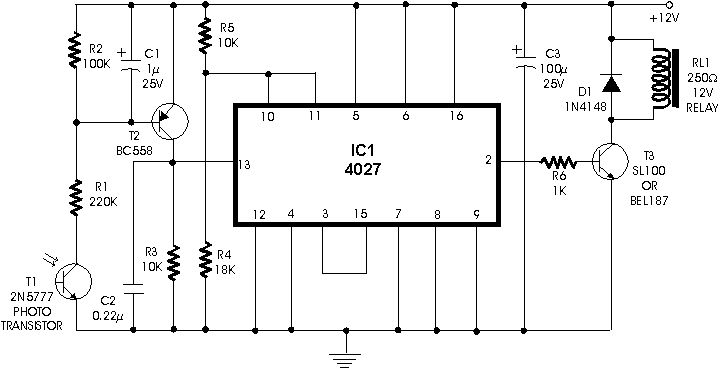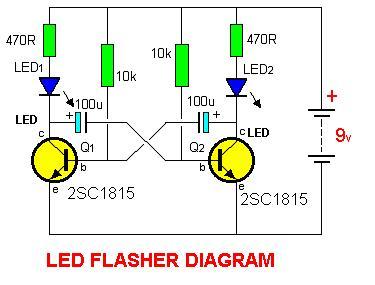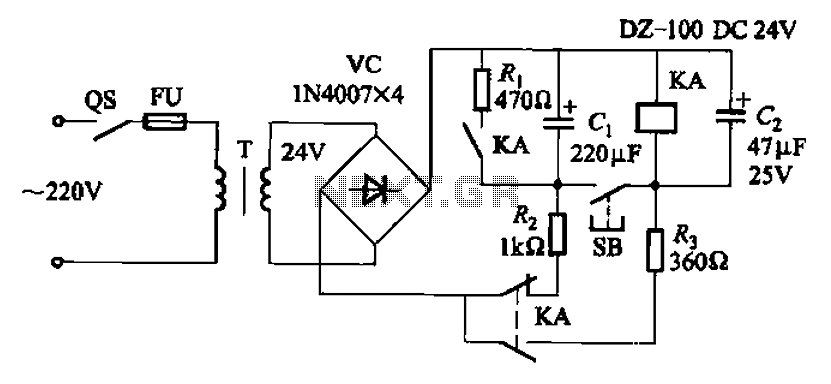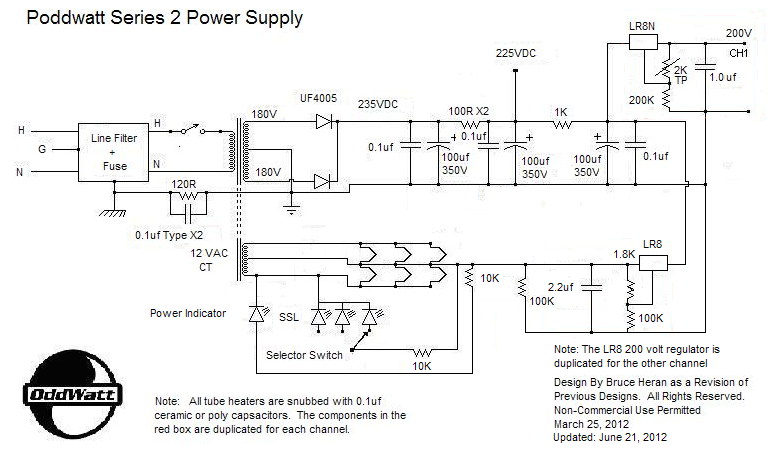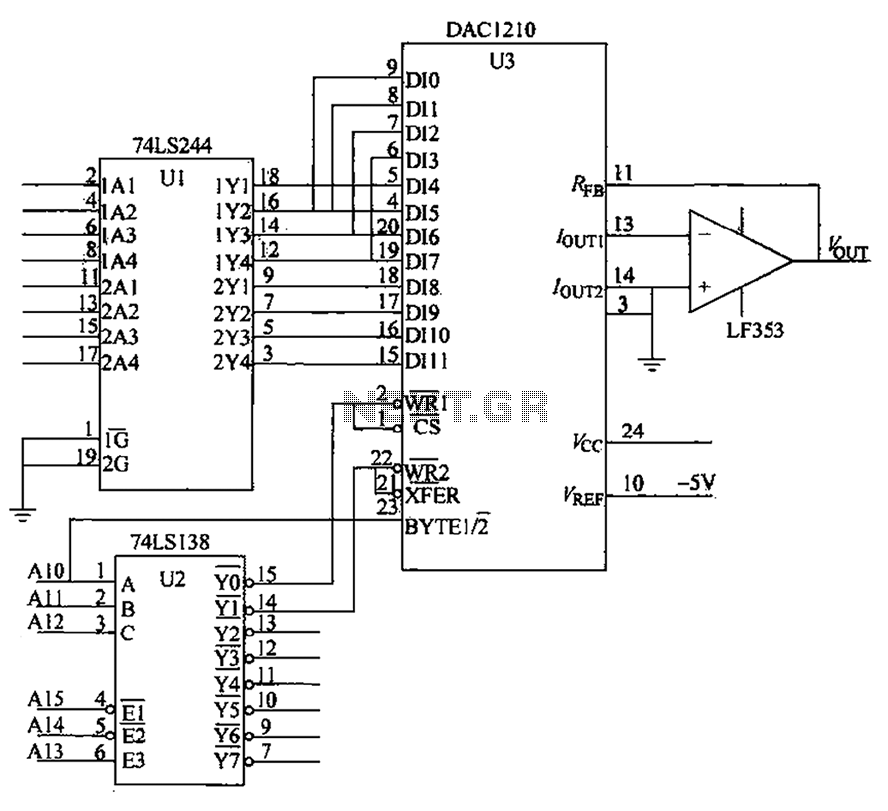
CD4013 Push Button CMOS Toggle Flip Flop
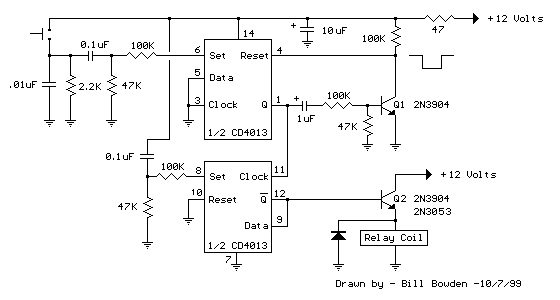
The circuit utilizes a CMOS dual D flip-flop (CD4013) to toggle a relay or other load using a momentary push button. Multiple push buttons can be connected in parallel to control the relay from various locations. A high signal from the push button is coupled to the set line through a small capacitor (0.1 µF). The high signal from the Q output is inverted by an upper transistor, providing a low reset signal to the reset line for approximately 400 ms. After this duration, the reset line returns to a high state, resetting the flip-flop. The lower flip-flop section is configured for toggle operation, changing state on the rising edge of the clock line or simultaneously with the upper flip-flop entering the set condition. The switch is debounced due to the brief duration of the set signal compared to the longer duration before the circuit resets. The Q or Q-bar outputs can only supply about 2 mA of current; therefore, a buffer transistor or power MOSFET is necessary to drive a relay coil, lamp, or other load. A 2N3904 or any small signal NPN transistor is suitable for relay coil resistances of 250 ohms or more, while a 2N3053 or a medium power (500 mA) transistor is recommended for coil resistances below 250 ohms. The 47-ohm resistor and 10 µF capacitor decouple the circuit from the power supply and filter out any transient noise signals. The RC network (0.1/47 kΩ) at the SET line (pin 8) acts as a power-on reset to ensure the relay remains de-energized when power is initially applied.
The circuit is designed to efficiently toggle a relay based on momentary push button inputs, utilizing a dual D flip-flop architecture for reliable state management. The CD4013 flip-flop is a versatile component, capable of handling various digital logic tasks, making it suitable for this application. By incorporating multiple push buttons in parallel, users can activate the relay from different locations, enhancing the circuit's usability in practical scenarios such as controlling lighting or appliances from multiple entry points.
The coupling capacitor (0.1 µF) plays a crucial role in ensuring that the momentary push button press generates a sufficient high signal to trigger the set line of the flip-flop. The subsequent inversion of the Q output by the upper transistor is essential for generating a controlled low reset signal, which temporarily disables the flip-flop's output and ensures that the relay does not remain activated indefinitely. The timing of the reset, approximately 400 ms, is carefully chosen to allow for a brief activation of the relay without causing unintended latching.
Debouncing is a critical aspect of the design, as mechanical switches can produce noise during actuation. The circuit's architecture mitigates this issue through the short duration of the set signal, ensuring that the flip-flop only responds to legitimate button presses.
The choice of output transistors is significant for driving loads. The 2N3904 is appropriate for higher resistance relay coils, while the 2N3053 is utilized for lower resistance applications, ensuring that the relay is activated efficiently without exceeding the current ratings of the transistors.
Additionally, the decoupling capacitor (10 µF) and the 47-ohm resistor serve a dual purpose: they stabilize the power supply against fluctuations and filter out any high-frequency noise that could affect circuit performance. The RC network connected to the SET line provides a reliable power-on reset function, ensuring that the relay remains off until the circuit is ready for operation, thereby enhancing safety and reliability in applications where the circuit may be powered on unexpectedly.The circuit below uses a CMOS dual D flip flop (CD4013) to toggle a relay or other load with a momentary push button. Several push buttons can be wired in parallel to control the relay from multiple locations. A high level from the push button is coupled to the set line through a small (0. 1uF) capacitor. The high level from the Q output is inverte d by the upper transistor and supplies a low reset level to the reset line for about 400 mS, after which time the reset line returns to a high state and resets the flip flop. The lower flip flop section is configured for toggle operation and changes state on the rising edge of the clock line or at the same time as the upper flip flop moves to the set condition.
The switch is debounced due to the short duration of the set signal relative to the long duration before the circuit is reset. The Q or Qbar outputs will only supply about 2 mA of current, so a buffer transistor or power MOSFET is needed to drive a relay coil, or lamp, or other load.
A 2N3904 or most any small signal NPN transistor can be used for relay coil resistances of 250 ohms or more. A 2N3053 or medium power (500 mA) transistor should be used for coil resistances below 250 ohms. The 47 ohm resistor and 10uF capacitor serve to decouple the circuit from the power supply and filter out any short duration noise signals that may be present.
The RC network (. 1/47K) at the SET line (pin 8) serves as a power-on reset to ensure the relay is denergized when circuit power is first applied. The reset idea was suggested by Terry Pinnell who used the circuit to control a shed light from multiple locations.
🔗 External reference
The circuit is designed to efficiently toggle a relay based on momentary push button inputs, utilizing a dual D flip-flop architecture for reliable state management. The CD4013 flip-flop is a versatile component, capable of handling various digital logic tasks, making it suitable for this application. By incorporating multiple push buttons in parallel, users can activate the relay from different locations, enhancing the circuit's usability in practical scenarios such as controlling lighting or appliances from multiple entry points.
The coupling capacitor (0.1 µF) plays a crucial role in ensuring that the momentary push button press generates a sufficient high signal to trigger the set line of the flip-flop. The subsequent inversion of the Q output by the upper transistor is essential for generating a controlled low reset signal, which temporarily disables the flip-flop's output and ensures that the relay does not remain activated indefinitely. The timing of the reset, approximately 400 ms, is carefully chosen to allow for a brief activation of the relay without causing unintended latching.
Debouncing is a critical aspect of the design, as mechanical switches can produce noise during actuation. The circuit's architecture mitigates this issue through the short duration of the set signal, ensuring that the flip-flop only responds to legitimate button presses.
The choice of output transistors is significant for driving loads. The 2N3904 is appropriate for higher resistance relay coils, while the 2N3053 is utilized for lower resistance applications, ensuring that the relay is activated efficiently without exceeding the current ratings of the transistors.
Additionally, the decoupling capacitor (10 µF) and the 47-ohm resistor serve a dual purpose: they stabilize the power supply against fluctuations and filter out any high-frequency noise that could affect circuit performance. The RC network connected to the SET line provides a reliable power-on reset function, ensuring that the relay remains off until the circuit is ready for operation, thereby enhancing safety and reliability in applications where the circuit may be powered on unexpectedly.The circuit below uses a CMOS dual D flip flop (CD4013) to toggle a relay or other load with a momentary push button. Several push buttons can be wired in parallel to control the relay from multiple locations. A high level from the push button is coupled to the set line through a small (0. 1uF) capacitor. The high level from the Q output is inverte d by the upper transistor and supplies a low reset level to the reset line for about 400 mS, after which time the reset line returns to a high state and resets the flip flop. The lower flip flop section is configured for toggle operation and changes state on the rising edge of the clock line or at the same time as the upper flip flop moves to the set condition.
The switch is debounced due to the short duration of the set signal relative to the long duration before the circuit is reset. The Q or Qbar outputs will only supply about 2 mA of current, so a buffer transistor or power MOSFET is needed to drive a relay coil, or lamp, or other load.
A 2N3904 or most any small signal NPN transistor can be used for relay coil resistances of 250 ohms or more. A 2N3053 or medium power (500 mA) transistor should be used for coil resistances below 250 ohms. The 47 ohm resistor and 10uF capacitor serve to decouple the circuit from the power supply and filter out any short duration noise signals that may be present.
The RC network (. 1/47K) at the SET line (pin 8) serves as a power-on reset to ensure the relay is denergized when circuit power is first applied. The reset idea was suggested by Terry Pinnell who used the circuit to control a shed light from multiple locations.
🔗 External reference
